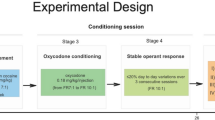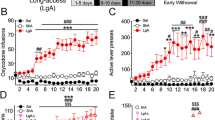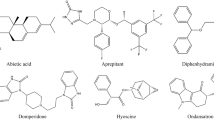Abstract
Rats categorized as high responder (HR), based on their activity in an inescapable novel environment, self-administer more amphetamine than low responder (LR) rats. The current study examined if the central nucleus of the amygdala (ACe) contributes to the elevated response for amphetamine in HR rats. Male Sprague–Dawley rats were classified as HR and LR rats based on their activity in inescapable novelty and novelty place preference, and then were trained to self-administer amphetamine (0.1 mg/kg/infusion). Once stable responding was achieved, rats received microinfusions of the GABAA agonist muscimol (0.5 μg/0.5 μl) or phosphate-buffered saline into the ACe immediately before self-administration of amphetamine (0.1, 0.03, 0.01, or 0.001 mg/kg/infusion) or saline. An additional group of rats was trained to lever press for sucrose rather than amphetamine. Based on the inescapable novelty test, HR rats self-administered more amphetamine than LR rats at the 0.03 and 0.01 mg/kg/infusion unit doses; there were no significant individual differences in amphetamine self-administration based on the novelty place preference test. Inactivation of the ACe with muscimol decreased self-administration at the 0.03 and 0.01 mg/kg/infusion unit doses in HR rats, but had no effect on LR rats. ACe inactivation had no reliable effect on inactive lever responding and appeared to be region specific based on anatomical controls. In addition, while inactivation of the ACe decreased responding for sucrose, inactivation did not differentially affect HR and LR rats. These results suggest that the ACe contributes to the elevated rate of amphetamine self-administration in HR rats.
Similar content being viewed by others
Log in or create a free account to read this content
Gain free access to this article, as well as selected content from this journal and more on nature.com
or
References
Alheid GF, Heimer L (1988). New perspectives in basal forebrain organization of special relevance for neuropsychiatric disorders: the striatopallidal, amygdaloid, and corticopetal components of the substantia innominata. Neuroscience 27: 1–39.
Alleweireldt AT, Hobbs RJ, Taylor AR, Neisewander JL (2006). Effects of SCH-23390 infused into the amygdala or adjacent cortex and basal ganglia on cocaine seeking and self-administration in rats. Neuropsychopharmacology 31: 363–374.
Asan E (1997). Interrelationships between tyrosine hydroxylase-immunoreactive dopaminergic afferents and somatostatinergic neurons in the rat central amygdaloid nucleus. Histochem Cell Biol 107: 65–79.
Bardo MT, Donohew RL, Harrington NG (1996). Psychobiology of novelty seeking and drug seeking behavior. Behav Brain Res 77: 23–43.
Beaulieu S, DiPaolo T, Barden N (1986). Control of ACTH secretion by the central nucleus of the amygdala: implication of the serotonergic system and its relevance to the glucocorticoid delayed feedback mechanism. Neuroendocrinology 44: 247–254.
Bevins RA, Klebaur JE, Bardo MT (1997). Individual differences in response to novelty, amphetamine-induced activity and drug discrimination in rats. Behav Pharmacol 8: 113–123.
Bradberry CW, Gruen RJ, Berridge CW, Roth RH (1991). Individual differences in behavioral measures: correlations with nucleus accumbens dopamine measured by microdialysis. Pharmacol Biochem Behav 39: 877–882.
Burns LH, Everitt BJ, Robbins TW (1999). Effects of excitotoxic lesions of the basolateral amygdala on conditional discrimination learning with primary and conditioned reinforcement. Behav Brain Res 100: 123–133.
Cador M, Dulluc J, Mormede P (1993). Modulation of the locomotor response to amphetamine by corticosterone. Neuroscience 56: 981–988.
Cador M, Robbins TW, Everitt BJ (1989). Involvement of the amygdala in stimulus-reward associations: interaction with the ventral striatum. Neuroscience 30: 77–86.
Cain ME, Dotson WF, Bardo MT (2006). Individual differences in the effect of novel environmental stimuli prior to amphetamine self-administration in rats. Exp Clin Psychopharmacol 114: 389–401.
Cain ME, Saucier DA, Bardo MT (2005). Novelty seeking and drug use: contribution of an animal model. Exp Clin Psychopharmacol 13: 367–375.
Cain ME, Smith CM, Bardo MT (2004). The effect of novelty on amphetamine self-administration in rats classified as high and low responders. Psychopharmacology 176: 129–138.
Caine SB, Heinrichs SC, Coffin VL, Koob GF (1995). Effects of the dopamine D-1 antagonist SCH 23390 microinjected into the accumbens, amygdala, or striatum on cocaine self-administration in the rat. Brain Res 692: 47–56.
Cassell MD, Freedman LJ, Shi C (1999). The intrinsic organization of the central extended amygdala. In: McGinty JF (ed). Advancing from the Ventral Striatum to the Extended Amygdala: Implications for Neuropsychiatry and Drug Abuse. The New York Academy of Sciences: New York. pp 217–241.
Chefer VI, Zakharova I, Shippenberg TS (2003). Enhanced responsiveness to novelty and cocaine is associated with decreased basal dopamine uptake and release in the nucleus accumbens: quantitative microdialysis in rats under transient conditions. J Neurosci 23: 3076–3084.
Chevrette J, Stellar JR, Hesse GW, Markou A (2002). Both the shell of the nucleus accumbens and the central nucleus of the amygdala support amphetamine self-administration. Pharmacol Biochem Behav 71: 501–507.
Davis M, Whalen PJ (2001). The amygdala: vigilance and emotion. Mol Psychiatry 6: 13–34.
Dellu F, Mayo W, Vallee M, Maccari S, Piazza PV, Le Moal M et al (1996). Behavioral reactivity to novelty during youth as a predictive factor of stress-induced corticosterone secretion in the elderly—a life-span study in rats. Psychoneuroendocrinology 21: 441–453.
Deroche V, Marinelli M, Le Moal M, Piazza PV (1997). Glucocorticoids and behavioral effects of psychostimulants. II: cocaine intravenous self-administration and reinstatement depend on glucocorticoid levels. J Pharmacol Exp Ther 281: 1401–1407.
Dews PB, Wenger GR (1977). Rate-dependency of the behavioral effects of amphetamine. In: Thompson T, Dews PB (eds). Advances in Behavioral Pharmacology. Academic Press: New York. pp 167–212.
Donohew RL, Lorch EP, Palmgreen P (1991). Sensation seeking and targeting of televised anti-drug PSAs. In: Donohew L, Sypher H, Bukowski WJ (eds). Persuasive Communication and Drug Abuse Prevention. Lawrence Erlbaum: Hillsdale. pp 209–226.
Edeline JM, Hars B, Hennevin E, Cotillon N (2002). Muscimol diffusion after intracerebral microinjections: a reevaluation based on electrophysiological and autoradiographic quantifications. Neurobiol Learn Mem 78: 100–124.
Epping-Jordan MP, Markou A, Koob GF (1998). The dopamine D-1 receptor antagonist SCH 23390 injected into the dorsolateral bed nucleus of the stria terminalis decreased cocaine reinforcement in the rat. Brain Res 784: 105–115.
Exner M, Clark D (1993). Behaviour in the novel environment predicts responsiveness to d-amphetamine in the rat: a multivariate approach. Behav Pharmacol 4: 47–56.
Gingras MA, Cools AR (1997). No major differences in locomotor responses to dexamphetamine in high and low responders to novelty: a study of Wistar rats. Pharmacol Biochem Behav 57: 857–862.
Goeders NE, Guerin GF (1994). Non-contingent electric footshock facilitates the acquisition of intravenous cocaine self-administration in rats. Psychopharmacology 114: 63–70.
Goeders NE, Guerin GF (1996). Role of corticosterone in intravenous cocaine self-administration in rats. Neuroendocrinology 64: 337–348.
Gray TS, Magnuson DJ (1987). Neuropeptide neuronal efferents from the bed nucleus of the stria terminalis and central amygdaloid nucleus to the vagal dorsal complex in the rat. J Comp Neurol 262: 365–374.
Hall J, Parkinson JA, Connor TM, Dickinson A, Everitt BJ (2001). Involvement of the central nucleus of the amygdala and nucleus accumbens core in mediating Pavlovian influences on instrumental behaviour. Eur J Neurosci 13: 1984–1992.
Heimer L, deOlmos J, Alheid GF, Zaborsky L (1991). ‘Perestroika’ in the basal forebrain: opening the border between neurology and psychiatry. In: Holstege G (ed). Progress in Brain Research. Elsevier: Amsterdam. pp 109–165.
Hitchcott PK, Phillips GD (1998). Double dissociation of the behavioral effects of R(+) 7-OH-DPAT infusions in the central and basolateral amygdala nuclei upon Pavlovian and instrumental conditioned appetitive behaviors. Psychopharmacology 140: 458–469.
Hooks MS, Jones GH, Smith AD, Neill DB, Justice JB (1991). Individual differences in locomotor activity and sensitization. Pharmacol Biochem Behav 38: 467–470.
Jongen-Relo AL, Amaral DG (1998). Evidence for a GABAergic projection from the central nucleus of the amygdala to the brainstem of the macaque monkey: a combined retrograde tracing and in situ hybridization study. Eur J Neurosci 10: 2924–2933.
Kabbaj M (2006). Individual differences in vulnerability to drug abuse: the high responders/low responders model. CNS Neurol Disord Drug Targets 5: 513–520.
Kabbaj M, Devine DP, Savage VR, Akil H (2000). Neurobiological correlates of individual differences in novelty seeking behavior in the rat: differential expression of stress-related molecules. J Neurosci 20: 6893–6988.
Kabbaj M, Norton CS, Kollack-Walker S, Watson SJ, Robinson TE, Akil H (2001). Social defeat alters acquisition of cocaine self-administration in rats: role of individual differences in cocaine-taking behavior. Psychopharmacology 158: 382–387.
Kapp B, Silverstri A, Guaracci F, Moynihan JE, Cain ME (1997). Associative and EEG arousal-related characteristics of amygdaloid central nucleus neurons in the rabbit. Soc Neurosci Abstr 23: 787.
Kapp BS, Cain ME (2001). The neural basis of arousal. In: Smelser NJ, Battes PB (eds). International Encyclopedia of the Social and Behavioral Sciences. Elsevier Science: New York. pp 754–758.
Kapp BS, Whalen PJ, Silvestri AJ, Jordan MP, Fechter JH (1993). The effect of amygdaloid lesions on the acquisition of EEG and heart rate conditioned responses in the rabbit. Soc Neurosci Abstr 19: 1230.
Kesner RP, Walser RD, Winzenried G (1989). Central but not basolateral amygdala mediates memory for positive affective experiences. Behav Brain Res 33: 189–195.
Killcross S, Robbins TW, Everitt BJ (1997). Different types of fear-conditioned behaviour mediated by separate nuclei within amygdala. Nature 388: 377–380.
Klebaur JE, Bardo MT (1999). Individual differences in novelty seeking on the playground maze predict amphetamine conditioned place preference. Pharmacol Biochem Behav 63: 131–136.
Klebaur JE, Bevins RA, Segar TM, Bardo MT (2001). Individual differences in behavioral responses to novelty and amphetamine self-administration in male and female rats. Behav Pharmacol 12: 267–275.
Knapska E, Walasek G, Nikolaev E, Neuhausser-Wespy F, Lipp HP, Kaczmarek L et al (2006). Differential involvement of the central amygdala in appetitive versus aversive learning. Learn Mem 13: 192–200.
Kruzich PJ, See RE (2001). Differential contributions of the basolateral and central amygdala in the acquisition and expression of conditioned relapse to cocaine-seeking behavior. J Neurosci 21: RC155.
Li CS, Mazzoni P, Andersen RA (1999). Effect of reversible inactivation of macaque lateral intraparietal area on visual and memory saccades. J Neurophysiol 81: 1827–1838.
Manning BH (1998). A lateralized deficit in morphine antinociception after unilateral inactivation of the central amygdala. J Neurosci 18: 9453–9470.
Mantsch JR, Saphier D, Goeders NE (1998). Corticosterone facilitates the acquisition of cocaine self-administration in rats: opposite effects of the type II glucocorticoid receptor agonist dexamethasone. J Pharmacol Exp Ther 287: 72–80.
Marinelli M (2005). The many aspects of the locomotor response to a novel environment test: theoretical comment on Mitchell, Cunningham, and Mark (2005). Behav Neurosci 119: 1144–1151.
Marinelli M, Piazza PV (2002). Interaction between glucocorticoid hormones, stress and psychostimulant drugs. Eur J Neurosci 16: 387–394.
Marinelli M, White FJ (2000). Enhanced vulnerability to cocaine self-administration is associated with elevated impulse activity of midbrain dopamine neurons. J Neurosci 20: 8876–8885.
Marowsky A, Yanagawa Y, Obata K, Vogt KE (2005). A specialized subclass of interneurons mediates dopaminergic facilitation of amygdala function. Neuron 48: 1025–1037.
Martin JH (1991). Autoradiographic estimation of the extent of reversible inactivation produced by microinjection of lidocaine and muscimol in the rat. Neurosci Lett 127: 160–164.
Martinez RC, de Oliveira AR, Brandao ML (2006). Conditioned and unconditioned fear organized in the periaqueductal gray are differentially sensitive to injections of muscimol into amygdaloid nuclei. Neurobiol Learn Mem 85: 58–65.
McEchron MD, McCabe PM, Green EJ, Llabre MM, Schneidermann NM (1995). Simultaneous single unit recordings in the medial geniculate nucleus and amygdaloid central nucleus through habituation, acquisition, and extinction of rabbits classically conditioned heart rate. Brain Res 682: 157–166.
McFarland K, Davidge SB, Lapish CC, Kalivas PW (2004). Limbic and motor circuitry underlying footshock-induced reinstatement of cocaine-seeking behavior. J Neurosci 24: 1551–1560.
Miczek KA, Mutschler NH (1996). Activational effects of social stress on IV cocaine self-administration in rats. Psychopharmacology 128: 256–264.
Misslin R, Herzog F, Koch B, Ropartz P (1982). Effects of isolation, handling, and novelty on the pituitary-adrenal response in the mouse. Psychoneuroendocrinology 7: 217–221.
Moreira CM, Masson S, Carvalho MC, Brandao ML (2007). Exploratory behaviour of rats in the elevated plus-maze is differentially sensitive to inactivation of the basolateral and central amygdaloid nuclei. Brain Res Bull 71: 466–474.
Nose I, Higashi H, Inokuchi H, Nishi S (1991). Synaptic responses of guinea pig and rat central amygdala neurons in vitro. J Neurophysiol 65: 1227–1241.
O’Dell LE, Sussman AN, Meyer KL, Neisewander JL (1999). Behavioral effects of psychomotor stimulant infusions into amygdaloid nuclei. Neuropsychopharmacology 20: 591–602.
Paxinos G, Watson C (1998). The Rat Brain in Stereotaxic Coordinates, 4th edn. Academic Press: San Diego.
Piazza PV, Deminiere JM, Le Moal M, Simon H (1989). Factors that predict individual vulnerability to amphetamine self-administration. Science 245: 1511–1513.
Piazza PV, Deminiere JM, Maccari S, Le Moal M, Mormede P, Simon H (1991a). Individual vulnerability to drug self-administration: action of corticosterone on dopaminergic systems as a possible pathophysiological mechanism. In: Willner P, Scheel-Kruger J (eds). The Mesolimbic Dopamine System: from Motivation to Action. Wiley: New York. pp 473–495.
Piazza PV, Deroche V, Deminiere JM, Maccari S, Le Moal M, Simon H (1993). Corticosterone in the range of stress-induced levels possesses reinforcing properties: implications for sensation-seeking behaviors. Proc Natl Acad Sci USA 90: 11738–11742.
Piazza PV, Le Moal M (1997). Glucocorticoids as a biological substrate of reward: physiological and pathophysiological implications. Brain Res Brain Res Rev 25: 359–372.
Piazza PV, Le Moal M (1998). The role of stress in drug self-administration. Trends Pharmacol Sci 19: 67–74.
Piazza PV, Rouge-Pont F, Deminiere JM, Kharoubi M, Le Moal M, Simon H (1991b). Dopaminergic activity is reduced in the prefrontal cortex and increased in the nucleus accumbens of rats predisposed to develop amphetamine self-administration. Brain Res 567: 169–174.
Pierre PJ, Vezina P (1997). Predisposition to self-administration amphetamine: the contribution of response to novelty and prior exposure to the drug. Psychopharmacology 129: 277–284.
Rebec GV, Grabner CP, Johnson M, Pierce RC, Bardo MT (1997). Transient increases in catecholaminergic activity in medial prefrontal cortex and nucleus accumbens shell during novelty. Neuroscience 76: 707–714.
Robinet PM, Rowlett JK, Bardo MT (1998). Individual differences in novelty-induced activity and the rewarding effects of novelty and amphetamine in rats. Behav Proc 44: 1–9.
Sanders SK, Shekhar A (1995). Regulation of anxiety by GABAA receptors in the rat amygdala. Pharmacol Biochem Behav 52: 701–706.
Smith Y, Pare D (1994). Intra-amygdaloid projections of the lateral nucleus in the cat: PHA-L anterograde labeling combined with postembedding GABA and glutamate immunocytochemistry. J Comp Neurol 342: 232–248.
Spanis CW, Bianchin MM, Izquierdo I, McGaugh JL (1999). Excitotoxic basolateral amygdala lesions potentiate the memory impairment effect of muscimol injected into the medial septal area. Brain Res 816: 329–336.
Stead JD, Clinton S, Neal C, Schneider J, Jama A, Miller S et al (2006). Selective breeding for divergence in novelty-seeking traits: heritability and enrichment in spontaneous anxiety-related behaviors. Behav Genet 36: 697–712.
Sun N, Yi H, Cassell MD (1994). Evidence for a GABAergic interface between cortical afferents and brainstem projection neurons in the rat central extended amygdala. J Comp Neurol 340: 43–64.
Wills TA, Vaccaro D, McNamara G (1994). Novelty seeking, risk taking, and related constructs as predictors of adolescent substance abuse: an application of Cloninger's theory. J Subst Abuse 6: 1–20.
Wills TA, Windle M, Cleary SD (1998). Temperament and novelty seeking in adolescent substance abuse: Convergence of dimensions of temperament with constructs from Cloninger's theory. J Pers Soc Psychol 74: 387–406.
Zuckerman M (1994). Behavioral Expressions and Biosocial Bases of Sensation Seeking. Cambridge University Press: Cambridge.
Acknowledgements
This research was funded by USPHS grant P50 DA05312. MEC supported by USPHS Grant F32 DA16013. We thank Justin Dixon, Bill Dotson, Laura Fenton, Nate Gilbertson, and Nichole Neugebauer for their assistance with this project.
Author information
Authors and Affiliations
Corresponding author
Additional information
DISCLOSURE/CONFLICT OF INTERESTS
The authors declare that this work was funded by NIH grants DA05312 and DA16013. We declare that, except for the income received from our primary employers, no financial support or compensation has been received from any individual or corporate entity over the past 3 years for research or professional service and there are no personal financial holdings that could be perceived as constituting a potential conflict of interests.
Rights and permissions
About this article
Cite this article
Cain, M., Denehy, E. & Bardo, M. Individual Differences in Amphetamine Self-Administration: The Role of the Central Nucleus of the Amygdala. Neuropsychopharmacol 33, 1149–1161 (2008). https://doi.org/10.1038/sj.npp.1301478
Received:
Revised:
Accepted:
Published:
Issue date:
DOI: https://doi.org/10.1038/sj.npp.1301478
Keywords
This article is cited by
-
Operant novelty seeking predicts cue-induced reinstatement following cocaine but not water reinforcement in male rats
Psychopharmacology (2023)
-
Inhibition of a cortico-thalamic circuit attenuates cue-induced reinstatement of drug-seeking behavior in “relapse prone” male rats
Psychopharmacology (2022)
-
Novelty-induced locomotor behavior predicts heroin addiction vulnerability in male, but not female, rats
Psychopharmacology (2022)
-
Prenatal Stress Exposure Increases the Excitation of Dopamine Neurons in the Ventral Tegmental Area and Alters Their Reponses to Psychostimulants
Neuropsychopharmacology (2013)
-
Sensory reinforcement as a predictor of cocaine and water self-administration in rats
Psychopharmacology (2013)



